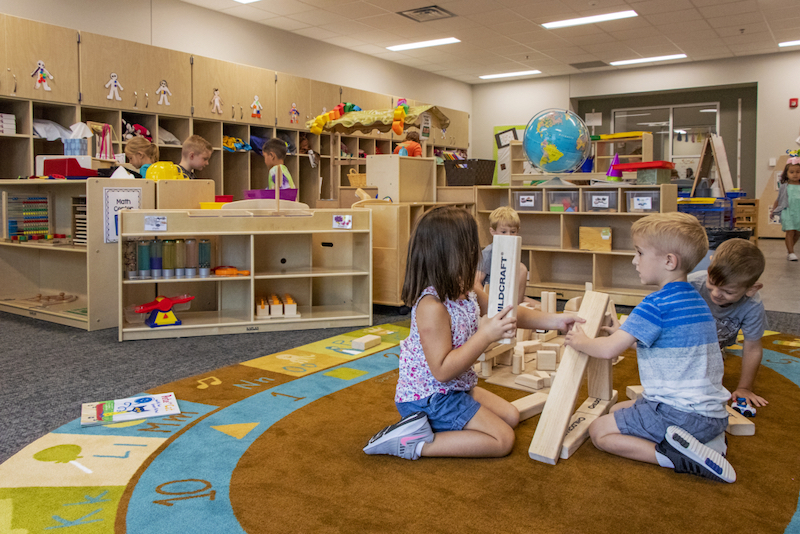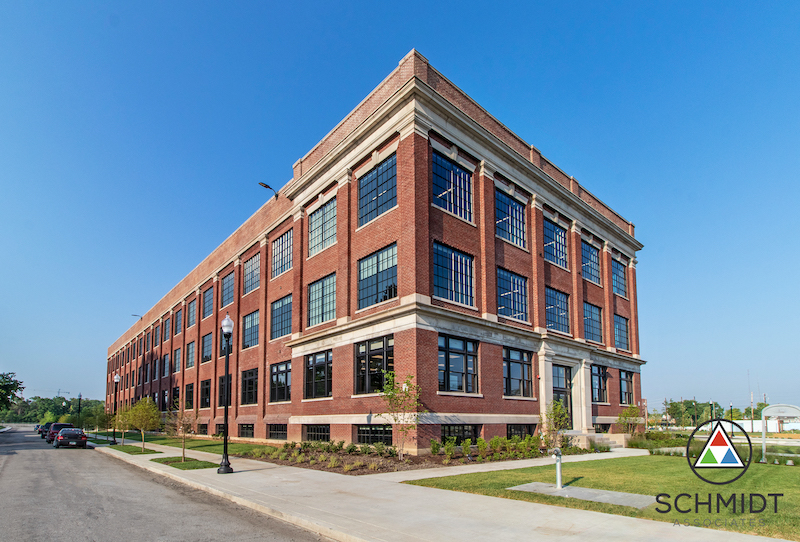The P.R. Mallory Building in Indianapolis was once where the Duracell battery was invented and patented. Vacant for decades, the 100-year-old building has been jolted back to life through an adaptive reuse project that converted the facility into new homes for the STEM-focused public charter school Purdue Polytechnic High School and Paramount Englewood Middle School.
The building team—AE firm Schmidt Associates, Brandt Construction, and landscape designer Anderson + Bohlander—was instrumental in helping Englewood Community Development and John Boner Neighborhood Centers, the building’s owners since 2018, to realize their vision.
“We were able to help the owners take something old and dilapidated, and turn it into something new and innovative that will improve lives long into the future,” says Lisa Gomperts, FAIA, LEED AP, Principal and Project Manager with Schmidt Associates.
REUSE DESIGN COMPLICATED BY NATIONAL REGISTRY

A before-and-after look at one of the building's areas. Large floor plates gave the design team lots of room for their ideas.
Adaptive reuse and historic preservation are among Schmidt’s specialties. For example, last year the firm converted an abandoned 62,000-sf strip mall in Shelbyville, Ind., into Golden Bear Preschool, a $13 million project that encompasses a SENSES gym for children with special needs, 15 classrooms, a cafeteria, and outdoor play area. The school’s administrative office is located inside what had been a bank at the end of the shopping center.
The Indianapolis schools, which opened last week, are contained within 114,256 sf over four floors. The project’s total cost was $38 million, of which $23.4 million was construction.
Click here to see an architectural tour of the building
The adaptive reuse presented some challenges. During the design phase, the owners initiated the process of putting the building on the National Register of Historic Places, which meant that any proposed designs needed approval from the National Parks Service, the Indiana Department of Natural Resources, and the city.
It took 23 months to get the building’s 206 historically accurate windows approved. The building itself also had an undocumented tunnel system that had to be filled in. And because that had once been a battery plant, environmental remediation was a given to make the space safe for students and faculty.
The building’s original wood columns and ceilings were stripped and restored, and other original elements were retained such as a catwalk and roof monitors, steel doors of the elevator and vaults, and the factory’s smokestack for future renovation. The original terrazzo tile that adorned the building’s north entryway was restored.
Also see: Hastings Architecture creates its new HQ from a former Nashville public library building
ARCHITECT HAD LOTS OF SPACE TO WORK WITH

Another of Schmidt Associates' adaptive reuse projects is Golden Bear Preschool, inside what once was a shopping mall in Shelbyville, Ind.
The nontraditional curricula of the educational tenants, and their relationship, drove the reuse design. The two institutions will be integrated with each other and Purdue University; for example, a middle-school student would receive priority admittance to Purdue Polytechnic, whose students receive direct admittance upon graduation to Purdue University.
The building has 56 classrooms: 31 for the high school including labs and a career readiness center; and 25 for the middle school.
The building’s expansive floor plates gave Schmidt an ample canvas for its design ideas. The building now features collaborative study lounges whose furniture can be broken down into pods; clean and dirty maker spaces; flexible classrooms with garage doors that open up or section off spaces as needed; and communal outdoor gathering areas. There is also a high level of technological integration between the schools.
Related Stories
Education Facilities | Aug 4, 2024
A former supersonic wind tunnel becomes a new educational facility for transportation design
The Mullin Transportation Design Center at ArtCenter College of Design in Pasadena, Calif., provides access for full-scale vehicular models, replicating a professional design studio.
Adaptive Reuse | Jul 30, 2024
Empty mall to be converted to UCLA Research Park
UCLA recently acquired a former mall that it will convert into the UCLA Research Park that will house the California Institute for Immunology and Immunotherapy at UCLA and the UCLA Center for Quantum Science and Engineering, as well as programs across other disciplines. The 700,000-sf property, formerly the Westside Pavilion shopping mall, is two miles from the university’s main Westwood campus. Google, which previously leased part of the property, helped enable and support UCLA’s acquisition.
Great Solutions | Jul 23, 2024
41 Great Solutions for architects, engineers, and contractors
AI ChatBots, ambient computing, floating MRIs, low-carbon cement, sunshine on demand, next-generation top-down construction. These and 35 other innovations make up our 2024 Great Solutions Report, which highlights fresh ideas and innovations from leading architecture, engineering, and construction firms.
Adaptive Reuse | Jul 12, 2024
Detroit’s Michigan Central Station, centerpiece of innovation hub, opens
The recently opened Michigan Central Station in Detroit is the centerpiece of a 30-acre technology and cultural hub that will include development of urban transportation solutions. The six-year adaptive reuse project of the 640,000 sf historic station, created by the same architect as New York’s Grand Central Station, is the latest sign of a reinvigorating Detroit.
MFPRO+ News | Jun 24, 2024
‘Yes in God’s Backyard’ movement could create more affordable housing
The so-called “Yes in God’s Backyard” (YIGBY) movement, where houses of worship convert their properties to housing, could help alleviate the serious housing crisis affecting many communities around the country.
Multifamily Housing | Jun 14, 2024
AEC inspections are the key to financially viable office to residential adaptive reuse projects
About a year ago our industry was abuzz with an idea that seemed like a one-shot miracle cure for both the shockingly high rate of office vacancies and the worsening housing shortage. The seemingly simple idea of converting empty office buildings to multifamily residential seemed like an easy and elegant solution. However, in the intervening months we’ve seen only a handful of these conversions, despite near universal enthusiasm for the concept.
Adaptive Reuse | Jun 13, 2024
4 ways to transform old buildings into modern assets
As cities grow, their office inventories remain largely stagnant. Yet despite changes to the market—including the impact of hybrid work—opportunities still exist. Enter: “Midlife Metamorphosis.”
Adaptive Reuse | Jun 6, 2024
Latest phase of London redevelopment completes two new buildings
Developers are creating a neighborhood for 25,000 residents and workers.
MFPRO+ News | Jun 3, 2024
New York’s office to residential conversion program draws interest from 64 owners
New York City’s Office Conversion Accelerator Program has been contacted by the owners of 64 commercial buildings interested in converting their properties to residential use.
Adaptive Reuse | May 15, 2024
Modular adaptive reuse of parking structure grants future flexibility
The shift away from excessive parking requirements aligns with a broader movement, encouraging development of more sustainable and affordable housing.

















